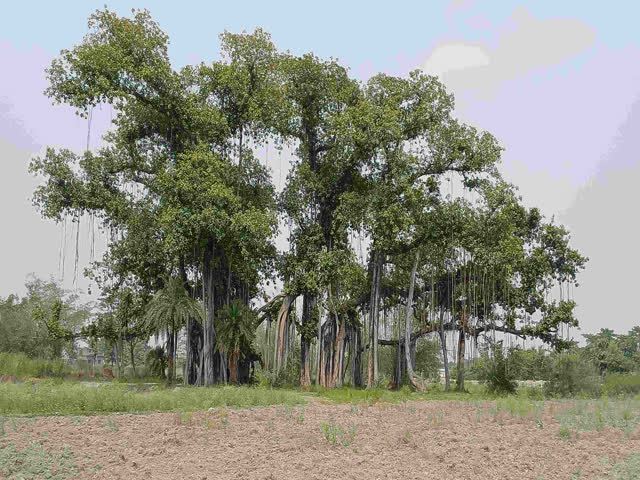WATCH: 150-Yrs-Old Banyan Tree Grows Like a Mini Forest with 200 Trunks; 5 Degrees Cooler than Surroundings
🎬 Watch Now: Feature Video


Published : Jun 10, 2024, 10:24 PM IST
Gopalganj : A 150 years-old huge banyan tree near the Sonasati Devi temple in Baikunthpur block of Gopalganj district has become a subject of curiosity. Because this single tree is looking like a small forest today, having 200 trunks. It is said that once the British used to cultivate indigo here, after which they planted the banyan tree.
Near this tree, there used to be the ruins of a British mansion, which is no more there while the Banyan tree is still standing strong. In those days, the British had preserved this tree so that puja could be performed and the workers could get shade. It was used as a place of temporary rest for women who come from the surrounding area to worship Sonasati Devi.
Cool Shade: The specialty of this tree is that the temperature in the middle and below this tree is 5 to 6 degrees lower than other places. During summer also, hot winds will turn cool down after reaching its shade. The branches of this tree have intertwined with each other and its thick roots sank deep in the ground.
According to environmental experts, the thick roots of this Banyan tree absorb 50 kilograms of carbon dioxide. These branches themselves act as filters to absorb carbon. In this context, environmentalist Dr. Sanjay Pandey said that there is a scientific reason for this tree. Banyan or Peepal trees absorb carbon dioxide by doing photosynthesis from the rays of the sun and provide oxygen.
"The temperature rise is also due to the high amount of carbon in the atmosphere. Big trees absorb carbon from the atmosphere. This tree is so big that it can absorb more than 260 tons of carbon in a year. Due to the factories, the air quality index here is around 240. But if you measure the AQI level from Google near this huge banyan tree, you will find it to be much lower. " - Dr. Sanjay Pandey, Environmentalist
Botanical Name: Botany lecturer and environmentalist Manoj Kumar Singh said that it is called Akshay Vat. Its botanical name is Ficus religiosa. Its family is Moraceae. Its branches absorb 50 to 60 kilograms of carbon dioxide. "Due to absorbing more carbon, it emits more oxygen. This is the reason that when the outside temperature is between 40 to 42 degrees Celsius, the mercury in its shade remains 35 to 36 degrees. " - Manoj Kumar Singh, Environmentalist
70-year-old Vindeshwari Rai, a resident of Hamidpur village, said that this tree was from before they were born. "This tree was planted during the British era and was spread over one bigha of land. Gradually, encroachment took place here and its area got reduced. Puja is performed. It feels very cold here. During rainy season, it turns into a dense forest here. There is no place to go out from here." - Vindeshwari Rai, local resident.
Read More:
1. WATCH Human-Elephant Conflict: Assam Woman Attacked By Wild Animal





